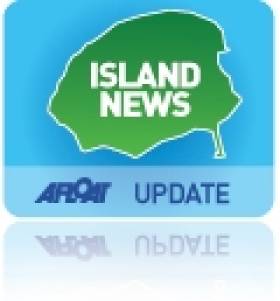Displaying items by tag: Verolme Dry Dock
Cape Clear Lock Chamber Delivery & Installation
#capeclear – As Afloat.ie reported earlier this month, L&M Keating Ltd, a building and civil engineering contractor, successfully towed and installed the contractor designed 1000t reinforced concrete lock chamber for a new storm gate on Cape Clear Island, Co. Cork from its casting basin in Verolme Dry Dock in Cork Harbour to the island, a tow of approximately 100 kilometres. L&M Keating Director Richard Browne describes how the work was completed.
Cape Clear is Ireland's most southerly island being 6 miles off Cork's Atlantic Coast in exposed waters just a few miles from the Fastnet Rock Lighthouse. To protect the islands boating fleet during severe storms the Irish Department of Agriculture Food and the Marine have commissioned hydraulically operated storm gates to enable the inner harbour to be rapidly closed off. These gates require a substantial concrete structure to accurately hold and align the gates, in a water depth varying from 4 to 8 meters.
In response to the Departments tender invitation L&M Keating Ltd. offered a novel solution involving the precasting of the lock in a dry dock in Cork Harbour and installing temporary steel stop logs to form an enclosed chamber that would float. This chamber was then towed to site and sank on to a prepared concrete base.
After a week of pre tow preparation in the dry dock involving the installation of a deck, emergency pumping arrangements, ballasting, fitting of navigation marks and sea fastening works the sea structure was towed to sea the morning of Saturday 27th September.
The chamber was towed by the 4,000hp tug "Celtic Isle" provided by the Mainport Group, and was accompanied out of Cork Harbour by the Port Authorities tug "Gerry O'Sullivan".
Once at sea the chamber was towed at an average speed of 3.5knts arriving at Cape Clear in the early hours of Sunday 29th. The tow was then transferred to the smaller vessels "Barracuda" Vincent O'Driscoll's tug boat and Diarmuid O'Donovan's boat "Souris", and was brought into its final position against temporary steel guides. As the tide dropped the chamber followed the guides down until it rested on a concrete bed prepared earlier by divers. Once on the bottom, the chamber was flooded to prevent it floating off again.
The works are part of a €4.3M development which includes a 70m slipway, automated hydraulic storm gates (12x8m) and reconfiguration of the existing harbour entrance.
Work now continues to tie the quay on each side of structure in to the chamber, seal anchor the chamber with grout and to install and the electrical and hydraulic system commences.
























































